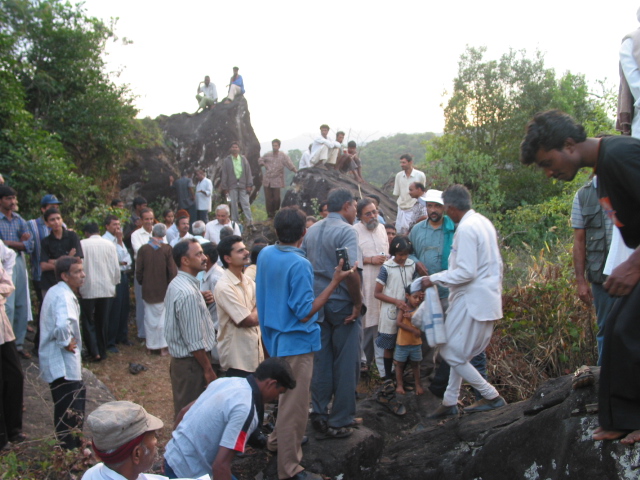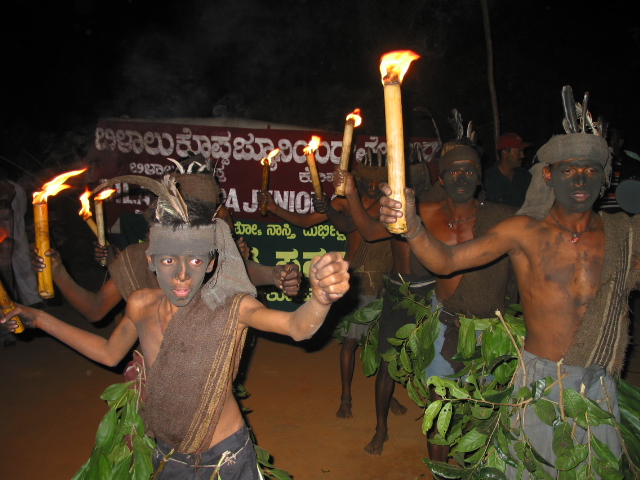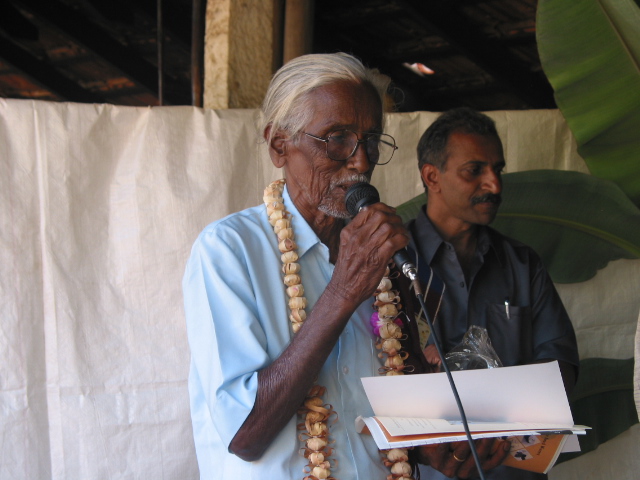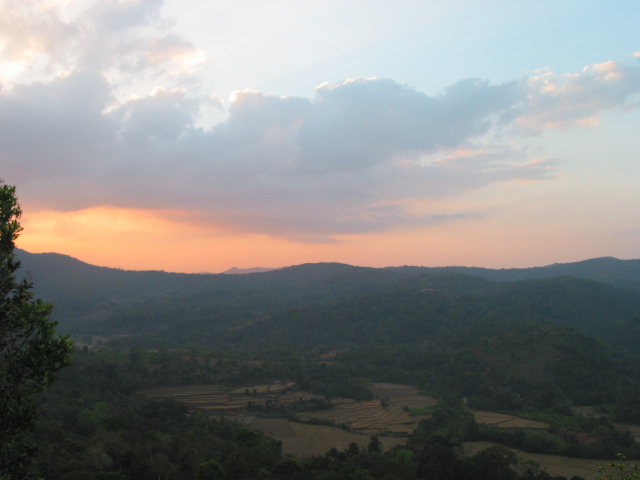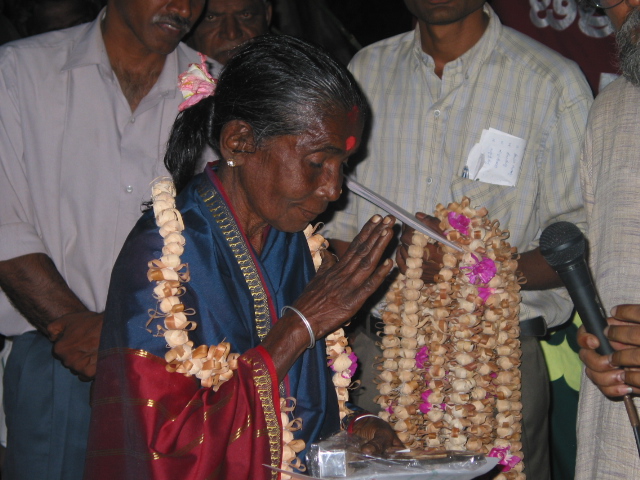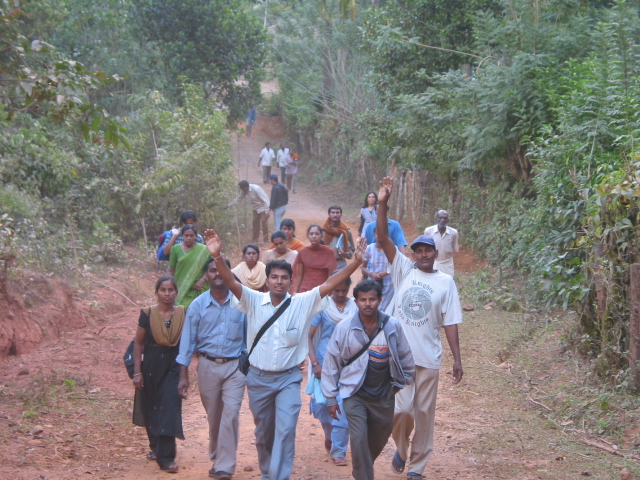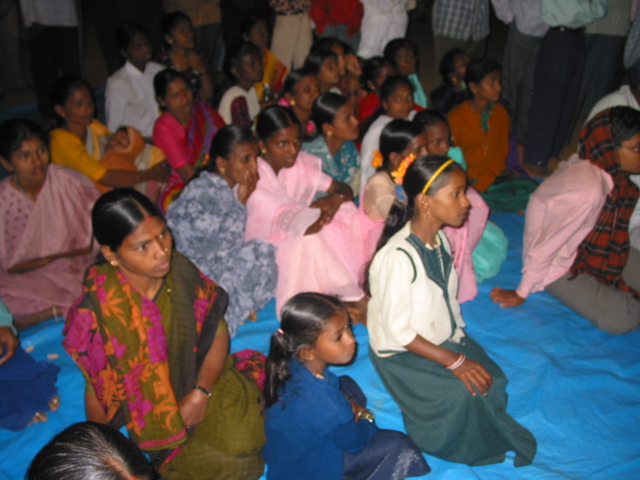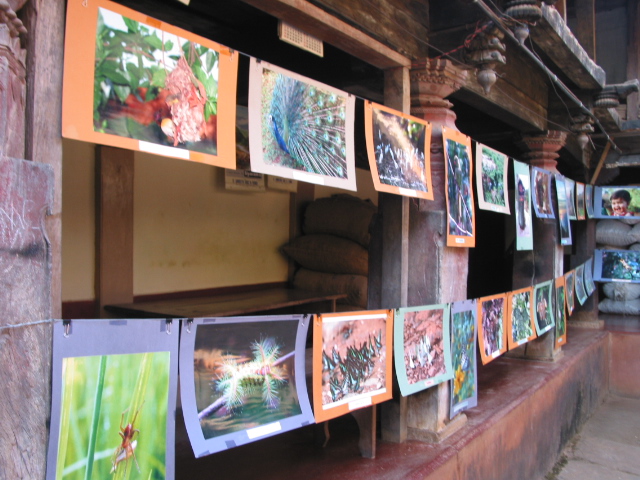Get Next Shodhyatra Update:
Phone:
079-27913293, 27912792
Email:
shodhyatra@sristi.org
12TH SHODHYATRA KOPA TOWN TO SHRUNGERI MALNAD (KARNATAKA)
Day 1
The journey started from Guddet hota village in Jaipura. The first day of the shodhyatra saw the beginning of the felicitation programmes that we would be holding at the different villages. We also had the opportunity to see the villagers perform for us in a cultural programme. One farmer, Venkatapaiyya, told us that today we have to start two journeys, one of our inner self and another, the outer shodhyatra. We need to undertake both these journeys and we can’t do one in the absence of other.
Among the people who were facilitated during the meet was a woman, who after being insulted by a contractor (for whom she worked), turned into a contractor herself, a 75 yrs old herbal healer who treat humans and animals, an educator who taught students well and was himself not concerned about monetary returns. Jagdish, an organic farmer, who gets optimum production in his field without using fertilizer, a herbal healer Shardaamma who treats newborn children and is also well versed on matters dealing with maternity. (only Rs 5 and a coconut for her work), Sheshgiri, a newspaper reporter, who is known as a moving library of this area. Venkama Tamegoda, 65 yr old maternity specialist who uses herbal medicines.
The shodhyatris had lemon juice withkamkasturi (Ocimum basilium) added in it and it proved to be an effective coolant. We were also shown hagdumbe (Lobelia nicotinifolia) which is used as a weedicide and chagtesapu (Cassia tora) which is used for treatment of piles. We also stopped in small village named Shanthigramaand gave awards to: Babugoda, a 65 yr old herbal healer who treats humans and animals, Senaiya for his talent and proficiency in tribal folk songs, even though he is illiterate, Puttegoda forAnteke-Pinteke (tribal song sung for a couple of hours continuously) without any reading, Amana Bhandari, who gives herbal medicines to animals and humans, especially for fire burns. She has been doing so for the last 30 yrs.
It was interesting to note that people here grow the vanilla but they do not use any chemicals in it as they say that its price falls if they do that.
We took our lunch at the home of V S Natraj in Guddethota and innovators were facilitated as well. These included a maternity specialist, a child and animal disease specialist. We also felicitated Singappa who has been doing organic farming in terms of growing rice organically for the last several yrs. He is also doing zero cultivation and his production is quite good. He said that his cost of production has actually fallen.
After this, the shodhyatris moved to Kalugopra (pathar ka gopra). There is a Jain temple there. It is also a picnic spot and is a great place to view sunsets. Later, we moved to the Herehala Ganapati temple in Harehala village on the Chigatanahala river. At night before dinner, we got the opportunity to see Kolata folk songs being rendered. It was a lot like dandiya. Several other dances were performed. It was an amazing experience.
Day 2
On December 26th, the shodhyatris reached Durgaparmeshwari temple in Haggarkudige in Koppa taluk. We heard Gujarati bhajans. Four persons were felicitated for beautiful wood sculpture work along with three nativaidhyas (ethno-veterinary surgeons)
Later, the shodhyatris moved to the next destination we observed cloves on trees, stevia (sweet tulsi), small hot pepper and peppermint. Here, people do not use chemicals to colour the arecanut and they use herbal colour. We reached Agalgandis school at 1:30 p.m. and had a meeting there. On our way, there was a field where vanilla grew. The vanilla plant gives fruit after 2.5-3 yrs. 1 kg of vanilla can fetch Rs 3,000.
The people who were felicitated were Kiramanatinmaiya for folk dance, centenarian Cheerama, Ravindra for preserving hegga rice (an indigenous variety), Raghuram for plucking supari branches from the top of plant, Ramana for dealing with social matters of the villagers, Chanderpratha for devising a rain gun which throws water up to 120 feet, Thyagaraja Komballi for his innovative art, Raghavendra for fine craft work, Seetharamaiah for treating herpes.
During our next stop at Dhayamballi, we got a warm welcome from the villagers. However, when we started felicitations we got a few questions and arguments from the villagers as well. When we were felicitating Ramkrishnan Acharya for his skills as a veterinarian, certain questions were raised by Ratnakar. They asked as to why were we felicitating only Ramkrishnan Acharya when everybody in the village knows about veterinary matters. To which we replied that this is because he is actually practicing the knowledge.
There is a difference between knowing a thing and actually implementing it practically. Others who were felicitated included Vedamma who specializes in contract farming of areca nut (an exception in this male dominated field) and a herbal healer, Bellaacharya who treats joints and bones of animals using herbal medicines and Kalasappa for his bamboo craft.
We also met the head of Transport Cooperative Society, Koppa, Chike Gowda. In this co-operative, all the members are also the owners. Besides doing their own work, the members also do cleaning and driving. Their total strength is 75. Later, we proceeded to Beluvinakodigae village where the sarpanch is Indira. We met Manjaya who can solder circuits using candle and torches of wood. Sivanna of Majhikoppa was felicitated for his herbal medicines that are useful in curing paralysis and asthma.
In this village, Sayed Ahmed has preserved old papers related to Ayurvedic medicine that his family had possessed for a long time. Others who were felicitated included Jayamma, Choddamma and Puttamma for their use of herbal medicines, Gaotamma for her special preparations of medicines for children, Nagesh for correcting problems related to bones of cattle (cow/buffalo), Marigoda for medicines for children and cattle problems, Mallaya for making baskets from bamboo sticks, Ayurvedic Doctor, Dr Vasudhev Ural, for making medicated arecanut juice for the treatment of gastric diseases, Krishna Rao for treating jaundice, Subrnaya and Krishnamurthy for culinary art, certain competitions were also held, in the recipe competition, Krishnayya got the first prize, Leelavati got an award for painting and drawing, Vijendra for snake bite medicines and Shivappacharya for snakebite medicines.
Day 3
On day three of the shodhyatra i.e. December 27th , the shodhyatris moved to Hurulihakkalu. There we went to Rajendra’s home which is said to be 120 year old and made of jackfruit wood. At the next stop, we felicitated Bilamma for her treatment of maternity-related problems and fire burns, Madhavrao for treating broken bones with a paste that he makes of a fruit, urad dal and other spices, Singappagoda for treating peoples who are poisoned i.e. he is a specialist in detoxification. Then, we had lunch at the residence of some relatives of Dr. Prakash. We got to sample traditional recipes like Appe kai saru (Made of a particular variety of Mango), paliya, sambar, gojju, sweet pickles, aathiras, huli (red rasam), majjegi.
People who were fecilated were Shantamaa for healing people using herbal medicines, Venkatrao for his medicines for diabetic patients, Krishnaiya for his herbal medicines for jaundice and herpes, Eshwarnayak for herbal medicine treatment for bone fracture, Ramchandra Rao for making organic manure for supari and has a small scale industry as well, Diwakara for his skill as a cartoonist, Bhaskar for being a progressive farmer. A recipe competition was also organized. Vina got the first award.
Now, we moved to our next destination which was Sringeri Math. But before that, we stopped at the garden of a farmer we had felicitated earlier. There we saw Eggfruit, Vanilla plantation, Baramasi mangos, Malayan apple, Drumstick, Butterfruit (avkauda).
At night, we reached Sringeri Math and also called on the swamiji. There was a felicitation ceremony where many people were felicitated. Shiv Das (50 yr old) for his Sharda printing press and magazines, Gopal Krishnan for his joint family of 30 members, Ratnama for her herbal medicines for herpes and jaundice, G G Ganesh who made electricity production project as well as a project for lifting water, D P Sunderacharya for his talent and skill in playing musical instruments, Narsimh Bhatt for giving medicines to childless persons and polio patients, Tamayya, a washerman who is the head of a 50 member family, Kinchaiya, a snake charmer, Chandrashekhar for medicines for snake bites, A P Rao who is a well connected person.
Day 4
On the day four, we moved to the next destination where we met Nagalinga who had made a bike-driven agriculture implement and had also got it registered in NIF. Among the people who were felicitated was a farmer who had studied an insect that attacks the areca nut plants. He had told his labourers to catch the insect and one ingenuous labourer realized that it is better to capture the female insect. The farmer pays more for catching female insect. C K Satyanarayanana for giving herbal medicines for animals, Ganapati who is an expert in treating snakebites, Rukmaniamma who is an expert in treating skin disease, problems affecting children, Krishnamurthy for areca deshelling (10kg/hr) and Narayan Bhatt for making a medicine for healing cracked heals.
A Biodiversity competition was organized for children. Puja, who got the first prize, could identify 150 different plants. Here, one schoolteacher said that a bridge needs to be developed between the last and the next generation so that our rich biodiversity can be protected.
During the journey, other people who were with us also shared information about their own farming practices and innovations. For instance, A J Bhalani had developed a porous micropipe-system for irrigation. During our halt at Kulugalu, we met a handicapped man who was full of life. He told us that when he had lost his leg, he had been hospitalized. There, he had met people who were afflicted with even bigger handicaps. This had taught him to be content with what he had and to continue to be motivated.
Later, we reached our next halt which was a school. We received a warm welcome from the students. Those who were felicitated were Shankarappa (98yrs old) for herbal medicines, Srinivasaiya who has been a snakebite healer for the last 50 yrs, Natraj who is a State level artist, Venkamma (80yrs old) who is a maternity specialist, Bellaya for plucking of arecanuts, P D Prakash for treatment of paralysis, K S Gopal Rao for solving problems related to land for other people and Shardamaa for starting a group, Shanthi Swasahaya Sangh, that helps raise economic status of others. She started her group by selling milk and later got a loan from a bank.
Day 5
On the fifth day the Shodhyatris sat together and shared their experiences and learnt a lot from each other. Jamnadas mentioned how people use ash as an insecticide in the jeera crop. Similarly, Jaswant (from Kutch) said that castor extract can be used in killing white ants.
Later, we saw a slide show prepared by Nagesh in which he explained the lifecycle of the areca insect and told us how chemicals cannot control the insects and that we can do so through bio-control in an economic manner.
Also, it was said that the desi maize variety has more boron and so is helpful for arthritis patients. Later, we moved to the next halt where NCC kids gave us a nice welcome and here Chandana (middle sections) who identified 50 plants won first prize in the Biodiversity competition. In the primary section, the winner Vaibhavi spotted more than 50 plants.
We had a felicitation ceremony where the following people were felicitated: Gitama for handling 500 successful maternity cases, Fatima for handling 200 maternity cases, Bellama for treating skin disease, Bullaya Goda for his medicines for problems related to eyesight and Gopal for treatment of snakebites.
At the village, we had been welcomed by Annapurna Mohan who is the head of Maeddi Jaycee Kammardi. We had heard a lot about her. There was also a school in this village that had been getting 100% results from last 3 years and interestingly, it doesn’t get any government aid.
There was a felicitation ceremony where the following people were felicitated: Vasudev Hebbar for treating jaundice, Krishnamurthy for jyotishmati medicine for childless couples, Srinivas Gaoda for treating snakebite and herpes, Laxmi Narayan Bhatt who is a novelist and also gives medicines for jaundice, snakebite, Shankara Shetty, a local paper reporter, Akamma who has completed 100 years and can still crush areca nut with her teeth, Ibrahim who is a repair mechanic, Chuddappa who is a herbal healer (treats animals), Jyadharna Gaoda fixes fractures in animals, Venkappa who can remove foreign bodies, dust etc from eyes of animals, Kamalamma who is a maternity specialist, Ganeshaiya, a herbal healer who cures migraines, Vaddirachariya for developing agricultural implements, Puttamma who can heal asthma and Srivatsa who initiated a self help group and also made a community seed bank.
At the next halt, the villagers had made arrangements for a campfire. They also sang songs. They were happy with the initiative that we had taken in terms of conserving biodiversity.
Day 6
On the sixth day i.e. December 30th , we stopped at one place where we saw the world’s second biggest rafda (snake home). This was at the Lokparmeshwari temple near Halmuttu village. In this village, Revti behan is the sarpanch and she herself welcomed us. As we made our way to the next stop, we saw rubber plants where areca leaves were being used to collect the extract. We reached our destination and began the felicitations. The people felicitated were: Beddaiya who makes toran for marriages and was also a panch of the village earlier, Ratnamma (a maternity expert), and Semmakka Naik who treats wounded animal feet. He said that he was willing to share his knowledge, but there was no one who wanted to learn. This particular issue could be resolved by creating awareness among youth by giving incentives to the person involved in this field and the panchayat could also help by giving some scholarship, providing help in patenting, creating a register of Biodiversity and provide incentives to Biodiversity restorers and by providing some training to school children who could be apprenticed to herbal healers.
Our next stop was the Kolavara village and we had to pass through the sacred Tunga river.
At the village, we felicitated the following: Subramanya Udupa (80 yrs old) culinary expert, Venkataiya (80yrs old), has promoted the water conservation ideology, Umesh Chandra who is an editor of a paper, C N Murthy who treats liver ailments, Ramaiya who cures herpes, Krishnmurthy who treats problems related to the bones of cows, Padmavati who is a maternity specialist, Laxmi Narayan who is a gastric specialist and Pramod who has been driving a car since he was nine years old.
We moved to another village where we felicitated Manjunatha H P for beautiful chalk work done on different articles and H M Wadianna who gives medicines to childless couples.
In the evening, we went to Hariharpur. People there had made rangolis. We first went to the Sharda Laxmi Narsimha Peeth and saw the Laxminarsimha and Shardamba temples. Those who were felicitated were: Churka for poetry, Chand Hussain and his wife for digging a 70 feet deep well on their own, Shashikala who runs a bangle shop and is also a maternity specialist and Arunachal Hebbar who has taken beautiful snaps of Kuduremukh which is very rich in biodiversity.
Day 7
On the seventh and last day of the shodhyatra the shodhyatris visited a gurukul at Chitrakut where students are taught according to the Vedic system of education. Students enroll at the age of ten and live and study here for another nine years. While Brahmin students join the math after that, others seek opportunities for self employment. Later, we saw the Agrahar temple on the banks of the Tunga River. In this temple, we saw paintings depicting scenes from Mahabharata and Ramayana.
We met Mr Chike Gowda who is the head of the Transport Cooperative Society (TCS). We got to know how TCS emerged. It all began when the workers rights were refused by the transport company and so they decided to form their own cooperative. The last felicitation programme was held in the Town Hall. We honoured few innovators in the urban area for social work and also honoured all those who had helped SRISTI in making the Shodhyatra a success
FLICKR GALLERY
